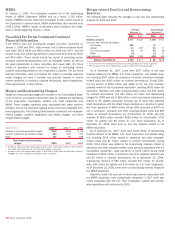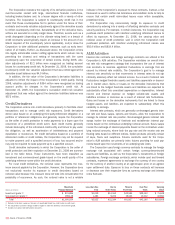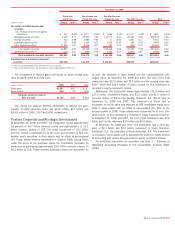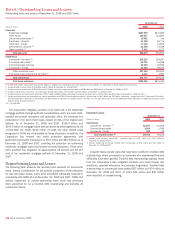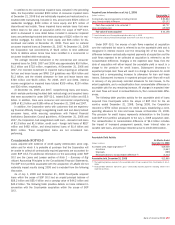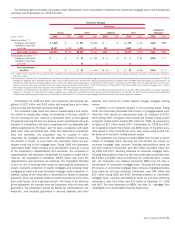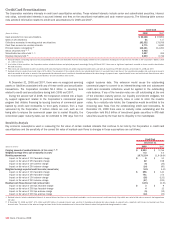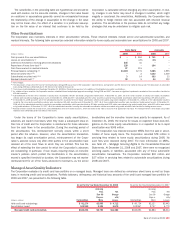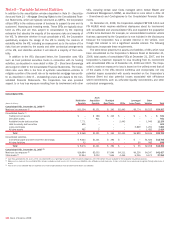Bank of America 2008 Annual Report Download - page 136
Download and view the complete annual report
Please find page 136 of the 2008 Bank of America annual report below. You can navigate through the pages in the report by either clicking on the pages listed below, or by using the keyword search tool below to find specific information within the annual report.
The Corporation executes the majority of its derivative positions in the
over-the-counter market with large, international financial institutions,
including broker/dealers and, to a lesser degree with a variety of other
investors. The Corporation is subject to counterparty credit risk in the
event that these counterparties fail to perform under the terms of their
contracts and records valuation adjustments against the derivative assets
to reflect counterparty credit risk. Substantially all of the derivative trans-
actions are executed on a daily margin basis. Therefore, events such as a
credit downgrade (depending on the ultimate rating level) or a breach of
credit covenants would typically require an increase in the amount of col-
lateral required of the counterparty (where applicable), and/or allow the
Corporation to take additional protective measures such as early termi-
nation of all trades. Further, as discussed above, the Corporation enters
into legally enforceable master netting agreements which reduce risk by
permitting the closeout and netting of transactions with the same
counterparty upon the occurrence of certain events. During 2008, valu-
ation adjustments of $3.2 billion were recognized as trading account
losses for counterparty credit risk. At December 31, 2008, the cumulative
counterparty credit risk valuation adjustment that was netted against the
derivative asset balance was $4.0 billion.
In addition, the fair value of the Corporation’s derivative liabilities is
adjusted to reflect the impact of the Corporation’s credit quality. During
2008, valuation adjustments of $364 million were recognized as trading
account profits for changes in the Corporation’s credit risk. At
December 31, 2008, the Corporation’s cumulative credit risk valuation
adjustment that was netted against the derivative liabilities balance was
$573 million.
Credit Derivatives
The Corporation enters into credit derivatives primarily to facilitate client
transactions and to manage credit risk exposures. Credit derivatives
derive value based on an underlying third party-referenced obligation or a
portfolio of referenced obligations and generally require the Corporation
as the seller of credit protection to make payments to a buyer upon the
occurrence of a predefined credit event. Such credit events generally
include bankruptcy of the referenced credit entity and failure to pay under
the obligation, as well as acceleration of indebtedness and payment
repudiation or moratorium. For credit derivatives based on a portfolio of
referenced credits or credit indices, the Corporation may not be required
to make payment until a specified amount of loss has occurred and/or
may only be required to make payment up to a specified amount.
Credit derivative instruments in which the Corporation is the seller of
credit protection and their expiration at December 31, 2008 are summar-
ized in the table below. These instruments have been classified as
investment and non-investment grade based on the credit quality of the
underlying reference name within the credit derivative.
For most credit derivatives, the notional value represents the max-
imum amount payable by the Corporation. However, the Corporation does
not exclusively monitor its exposure to credit derivatives based on
notional value because this measure does not take into consideration the
probability of occurrence. As such, the notional value is not a reliable
indicator of the Corporation’s exposure to these contracts. Instead, a risk
framework is used to define risk tolerances and establish limits to help to
ensure that certain credit risk-related losses occur within acceptable,
predefined limits.
The Corporation may economically hedge its exposure to credit
derivatives by entering into a variety of offsetting derivative contracts and
security positions. For example, in certain instances, the Corporation may
purchase credit protection with identical underlying referenced names to
offset its exposure. At December 31, 2008, the carrying value and
notional value of credit protection sold in which the Corporation held
purchased protection with identical underlying referenced names was
$92.4 billion and $819.4 billion.
ALM Activities
Interest rate contracts and foreign exchange contracts are utilized in the
Corporation’s ALM activities. The Corporation maintains an overall inter-
est rate risk management strategy that incorporates the use of interest
rate contracts to minimize significant fluctuations in earnings that are
caused by interest rate volatility. The Corporation’s goal is to manage
interest rate sensitivity so that movements in interest rates do not sig-
nificantly adversely affect net interest income. As a result of interest rate
fluctuations hedged fixed-rate assets and liabilities appreciate or depreci-
ate in market value. Gains or losses on the derivative instruments that
are linked to the hedged fixed-rate assets and liabilities are expected to
substantially offset this unrealized appreciation or depreciation. Interest
income and interest expense on hedged variable-rate assets and
liabilities increase or decrease as a result of interest rate fluctuations.
Gains and losses on the derivative instruments that are linked to these
hedged assets and liabilities are expected to substantially offset this
variability in earnings.
Interest rate contracts, which are generally non-leveraged generic inter-
est rate and basis swaps, options and futures, allow the Corporation to
manage its interest rate risk position. Non-leveraged generic interest rate
swaps involve the exchange of fixed-rate and variable-rate interest pay-
ments based on the contractual underlying notional amount. Basis swaps
involve the exchange of interest payments based on the contractual under-
lying notional amounts, where both the pay rate and the receive rate are
floating rates based on different indices. Option products primarily consist
of caps, floors and swaptions. Futures contracts used for the Corpo-
ration’s ALM activities are primarily index futures providing for cash pay-
ments based upon the movements of an underlying rate index.
The Corporation uses foreign currency contracts to manage the foreign
exchange risk associated with certain foreign currency-denominated
assets and liabilities, as well as the Corporation’s investments in foreign
subsidiaries. Foreign exchange contracts, which include spot and forward
contracts, represent agreements to exchange the currency of one country
for the currency of another country at an agreed-upon price on an agreed-
upon settlement date. Exposure to loss on these contracts will increase
or decrease over their respective lives as currency exchange and interest
rates fluctuate.
(Dollars in millions)
Maximum
Payout/Notional
(1)
Less than One
Year
One to
Three Years
Three to
Five Years
Over Five
Years
Carrying
Value
Investment grade
(2)
$ 801,886 $1,039 $13,062 $32,594 $29,153 $ 75,848
Non-investment grade
(3)
198,148 1,483 9,222 19,243 13,012 42,960
Total $1,000,034 $2,522 $22,284 $51,837 $42,165 $118,808
(1) Excludes total return swaps as they are not specifically linked to a credit index or credit event.
(2) The Corporation considers ratings of BBB- or higher to meet the definition of investment grade.
(3) Includes non-rated credit derivative instruments.
134
Bank of America 2008










